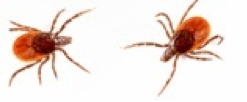
Serving Northeast & Central PA | Lehigh Valley | Pocono Mountains
Ticks are common across the United States, and there are over 25 species in Pennsylvania alone. The four species that you are most likely to encounter include the American dog tick, the blacklegged tick, the lone star tick and a brown dog tick. Ticks can cause Lyme disease in both animals and humans, Rocky Mountain Spotted Fever (RMSF) in humans and tick paralysis in animals and young children. Finding a tick on your body or in your dog’s fur doesn’t automatically mean that you will experience health issues related to tick bites, but it’s a risk that no one wants to take.
Why are there ticks in Pennsylvania?
In all likelihood ticks live near you. Ticks live in places such as unmanicured lawns, brush, along wood lines, tall grasses, fields, and parks. Areas with an abundance of tall foliage are conducive to tick activity, giving them a perfect place to latch onto while waiting for a host. When humans or animals such as pets walk through these areas of dense growth, ticks cling onto exposed skin to feed off of their new host. Pennsylvania is no exception, having one of the highest tick populations this season than ever before.
Dogs are just as venerable as humans to tick bites and infections. Spending time at dog parks, in backyards, and taking walks in the woods with their humans makes them exposed. Unlike humans, dogs are not clothed and walk lower to the ground, exposing nearly all of their body at all times. It is very important that you check your dog for tick symptoms and bites after spending time outdoors.
How can I remove a tick?
Trusting unqualified DIYers or getting tips from your friends and family can be dangerous when it comes to tick removal. Please follow our guide to ensure that you are treating the situation safely and effectively.
What not to do:
Using your hands – Not only is this extremely difficult, but you may squeeze the tick and release its infectious bodily fluids.
Petroleum jelly or nail polish– This will not make the tick any easier to remove. Ticks embed into a host with their mouths which are not likely to unlatch or dissolve by using this method.
Excessive heat– Using excessive heat could cause parts of the tick to break off such as its mouth, leaving parts in your skin that are open to infection.
What you should do:
Tweezers – Use fine-tipped tweezers to grasp the tick as close to the skins surface as possible.
Pull gently – Pull upward with steady, even pressure. Don’t twist or jerk the tick; this can cause the mouth-parts to break off and remain in the skin. If this happens, remove the mouth-parts with tweezers. If you are unable to remove the mouth easily with clean tweezers, leave it alone and let the skin heal.
Are ticks dangerous?

Ticks are dangerous due to the horrible diseases they could carry. Here are some examples of what can happen from only one tick bite:
- Lyme Disease – There are 30,000 cases of Lyme Disease reported yearly, and the condition is difficult to diagnose. Flu-like symptoms usually accompany it. The way most people identify a Lyme Disease carrying bite is through the bulls-eye appearance of the bitten area.
- Rocky Mountain Spotted Fever – This bacterial disease is fatal and it causes fever, headache, nausea, vomiting, stomach pain and weight loss. RMSF is typically spread from the American Dog Tick and is most popular from Oklahoma to North Carolina and all the states in between.
- Ehrlichiosis – We also have to worry about our furry friends. This condition affects humans, but it is most prevalent in dogs. It causes the death of white blood cells, which results in headache, fatigue, and soreness.
Do I need a tick lawn treatment?
Ticks have been making the headlines across national and local news outlets due to their resurgence and potential threats to your health and well-being. We suggest that you prepare for ticks even if you have never found ticks in your yard or have been bitten. Just because it hasn’t happened yet doesn’t mean that it can’t happen in an instant. A combination of preventative steps you can take on your own with the aid of professional pest control is the best way to assure that you can enjoy your yard this summer without the worry of tick-borne diseases.
Ticks need a host to survive. They live in tall grasses where they are concealed and can easily latch onto their victim. If your property is backed up to a wood line or you don’t regularly mow your lawn, it greatly increases your chances for tick activity. If your property has these elements, any host (dogs or humans) can fall prey to ticks, in turn bringing them indoors. If your dog was outdoors somewhere other than your property, there is a chance they can bring them back to your home. Dog parks, nature trails, and even walks around your neighborhood are common breeding grounds for ticks. Deer and other wild animals are even more susceptible to ticks simply because they live outdoors and venture back and forth between your yard and the woods or other natural habitats. Even homes without wood lines can fall victim to tick activity through visits from these critters.
How does Seitz Bros. get rid of ticks?
Seitz Bros. provides comprehensive disease-carrying pest control through the Mosquito and Tick Protection Plan. This prevention plan targets the areas where mosquitoes and ticks breed on your property. Treating your entire lawn is not necessary. Fill out the contact form on this page or give Seitz Bros. a call today to set up a free tick inspection at your home!
What are Ticks Pest Control in Pennsylvania & New Jersey?
Serving Northeast & Central PA | Lehigh Valley | Pocono Mountains | Western NJ
